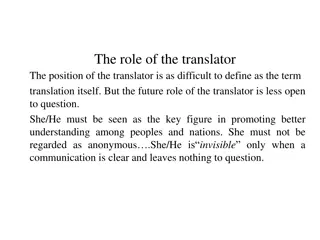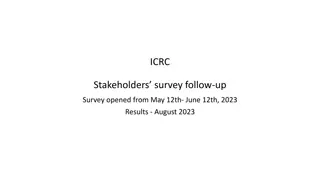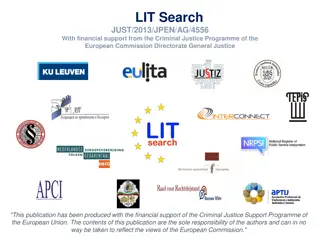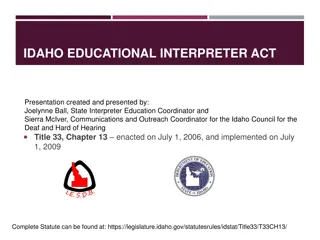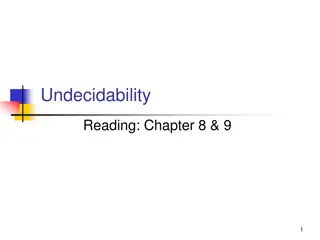Audio Description Guidelines in Modern Languages for Translators and Interpreters
Explore the various types and importance of audio description guidelines, covering topics like what to describe, when and how to describe, and dealing with thorny issues such as subjectivity and film techniques. Discover the differences between general approaches and strategies, along with examples of strategic guidelines for audio description. Learn about dealing with subjectivity according to the guidelines of the American Council for the Blind.
Download Presentation

Please find below an Image/Link to download the presentation.
The content on the website is provided AS IS for your information and personal use only. It may not be sold, licensed, or shared on other websites without obtaining consent from the author. Download presentation by click this link. If you encounter any issues during the download, it is possible that the publisher has removed the file from their server.
E N D
Presentation Transcript
AUDIO DESCRIPTION GUIDELINES MODULE 1 UNIT 7 NINA REVIERS UNIVERSITY OF ANTWERP Dept. of Legal, Language, Translation and Interpreting Studies, Section of in Modern Languages for Interpreters and Translators University of Trieste, Via Filzi, 14 - 34144 Trieste, Italy Project numberStudies: 2016-1-IT02-KA203-024311 www.adlabproject.eu FUNDED BY THE ERASMUS + PROGRAMME OF THE EUROPEAN UNION
IN THIS UNIT What types of AD guidelines exist? Why are AD guidelines important? What topics do AD guidelines cover? What are the differences between AD guidelines?
WHAT IS A GUIDELINE? Recommended course of action. Streamline the creation processes. Offer scripting strategies.
TYPES OF GUIDELINES Types of guidelines vary according to: Country. Type of AD. Purpose and scope.
IMPORTANCE OF GUIDELINES Guidelines support good quality. Guidelines can be binding.
AD GUIDELINE TOPICS What to describe? When to describe? How to describe? How to voice?
THORNY ISSUES Subjectivity. Film techniques. Colours. Ethnicity. Sound. Text on screen.
EXAMPLES ADLAB strategic guidelines for audio description available at www.adlabproject.eu
EXAMPLES Ofcom s Guidance On Standards for Audio Description .
DIFFERENCES General approach (prescriptive or strategic). Different strategies.
HOW TO DEAL WITH SUBJECTIVITY? The guidelines of the American Council for the Blind: Resist any temptation to convey what you may feel is inferred by them, such as an emotional state.
HOW TO DEAL WITH SUBJECTIVITY? Ofcom s Guidance On Standards for Audio Description : A few well-chosen words can enhance a scene considerably, but they must not reflect the personal view of the describer.
HOW TO DEAL WITH SUBJECTIVITY? ADLAB strategic guidelines: There are a range of possible strategies for describing a narrative event with different gradations in the explicitness of description (...).
HOW TO DEAL WITH SUBJECTIVITY? ADLAB strategic guidelines: A flashback versus Back in 1930 Her eyes open wide versus She is amazed Or a combination of these: Her eyes open wide in amazement.
AUDIO DESCRIPTION GUIDELINES MODULE 1 UNIT 7 NINA REVIERS UNIVERSITY OF ANTWERP Dept. of Legal, Language, Translation and Interpreting Studies, Section of in Modern Languages for Interpreters and Translators University of Trieste, Via Filzi, 14 - 34144 Trieste, Italy Project numberStudies: 2016-1-IT02-KA203-024311 Edited by: editor s first and last name www.adlabproject.eu FUNDED BY THE ERASMUS + PROGRAMME OF THE EUROPEAN UNION
The preparation of this presentation was supported by ADLAB PRO (Audio Description: A Laboratory for the Development of a New Professional Profile), financed by the European Union under the Erasmus+ Programme, Key Action 2 Strategic Partnerships, Project number:2016-1-IT02-KA203-024311.
The information and views set out in this presentation are those of the authors and do not necessarily reflect the official opinion of the European Union. Neither the European Union institutions and bodies nor any person acting on their behalf may be held responsible for the use which may be made of the information contained therein.









